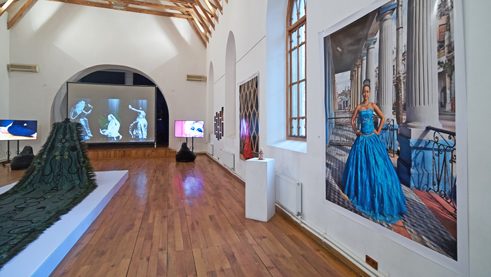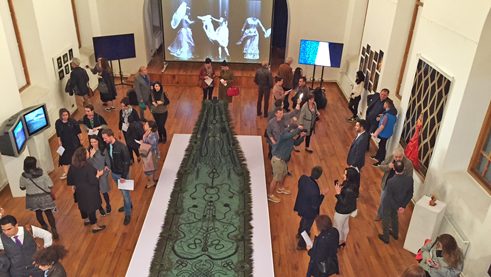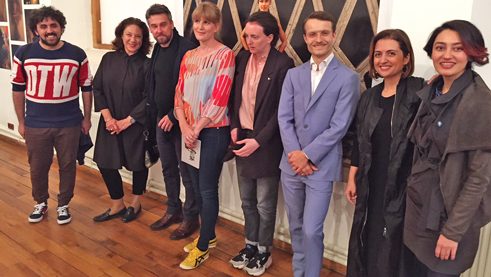Group Exhibition: A Doll’s House
My Selfie and I

Images of women: The group exhibition A Doll’s House at the Goethe-Zentrum Baku asks how women portray themselves in contemporary art. Artists including Andy Kassier, Leah Schrager and Leyla Alakbarova provide critical, ironic and playful answers.
Two panels at the entrance to the Kapellhaus in Baku, the capital of Azerbaijan, largely display the number 16 and a plus sign. This means that the Goethe-Zentrum’s international group exhibition A Doll’s House is only for viewers aged 16 and older. The exhibition title is taken from the play by the Norwegian dramatist Henrik Ibsen, which was published in 1879. The father and husband of the protagonist Nora treat her like a possession; her father acts as if she were a little doll and her husband as if she were a big doll, and she lives with her children like dolls. In the end, she leaves her husband and family, breaking out of her role as a good mother and housewife.
 The exhibition title refers to Hendrik Ibsen’s play of the same name.
| Photo: Adil Yusifov
In Baku, where the predominant religion is Shiite Islam, many young women live with their families until they are married. Often, men still decide where women are allowed to stay, what restaurants they are allowed to eat in or how they dress. Women wear headscarves; naked skin considered offensive. That explains the age restriction posted at the door.
The exhibition title refers to Hendrik Ibsen’s play of the same name.
| Photo: Adil Yusifov
In Baku, where the predominant religion is Shiite Islam, many young women live with their families until they are married. Often, men still decide where women are allowed to stay, what restaurants they are allowed to eat in or how they dress. Women wear headscarves; naked skin considered offensive. That explains the age restriction posted at the door.
Self-portrayals on Instagram
How do the sexes relate to one another nearly 150 years after Ibsen? What does the female image look like? How do women want to be seen? The 13 artists in the exhibition answer these questions differently. In the digital age, it makes sense to first look at social media when it comes to gender roles. The American artist Leah Schrager and the German artist Andy Kassier extensively researched male and female self-portrayals on Instagram. Women portray themselves in a home environment; they present themselves and their bodies as desirable, as if offering themselves to the male gaze and voluntarily turning themselves into objects. For her series “Shades of Pink,” Schrager went to a shooting location popular among young women in Los Angeles, the Pink Dollhouse. For his work “How to Take a Selfie,” by contrast, Andy Kassier was almost exclusively in the open air where young men present themselves as outdoorsmen and adventurers, flex their muscles, wear suits and stand in front of cars to demonstrate power and strength. In the background is a video installation by the Brazilian artist André Severo.
| Photo: Adil Yusifov
The exhibition begins with this status quo, with naked rears and naked skin. At the other end of the room, women and young girls dance gracefully in long, loose dresses in a video installation by the Brazilian artist André Severo. They turn in a circle, over and over again, like a GIF on social media. Yet the footage is as old as the play by Ibsen, the movement studies edited by Severo are by Eadweard Muybridge. The women exude grace and light-heartedness as they turn about like dolls. Next to them is a drag queen in the video “Narrative Reflection on Looking” by Victoria Sin, toy dolls in the series “Playground” by Leyla Alakbarova and young women on the threshold of adulthood in the work “Havana” by Frank Thiel. Alakbarova looks closely at the mass produced dolls, Frank Thiel at the young women: he shows them strong and self-confident, while strangers stare at the drag queen.
In the background is a video installation by the Brazilian artist André Severo.
| Photo: Adil Yusifov
The exhibition begins with this status quo, with naked rears and naked skin. At the other end of the room, women and young girls dance gracefully in long, loose dresses in a video installation by the Brazilian artist André Severo. They turn in a circle, over and over again, like a GIF on social media. Yet the footage is as old as the play by Ibsen, the movement studies edited by Severo are by Eadweard Muybridge. The women exude grace and light-heartedness as they turn about like dolls. Next to them is a drag queen in the video “Narrative Reflection on Looking” by Victoria Sin, toy dolls in the series “Playground” by Leyla Alakbarova and young women on the threshold of adulthood in the work “Havana” by Frank Thiel. Alakbarova looks closely at the mass produced dolls, Frank Thiel at the young women: he shows them strong and self-confident, while strangers stare at the drag queen. Artists of the exhibition A Doll’s House.
| Photo: Adil Yusifov
Artists of the exhibition A Doll’s House.
| Photo: Adil Yusifov